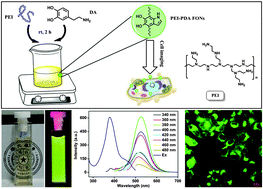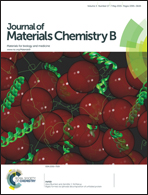Self-polymerization of dopamine and polyethyleneimine: novel fluorescent organic nanoprobes for biological imaging applications†
Abstract
The development of novel fluorescent nanoprobes has attracted great current research interest over the past few decades due to their superior optical properties and multifunctional capability as compared with small organic dyes. Although great advance has been made in the utilization of fluorescent nanoprobes for biomedical applications, development of novel fluorescent nanoprobes that possess good fluorescent properties, biocompatibility, biodegradability and water dispersibility through a convenient and effective route is still highly desirable. In this work, we reported for the first time that novel fluorescent organic nanoparticles (FONs) can be conveniently fabricated via self-polymerization of dopamine and polyethyleneimine at room temperature and in an air atmosphere within 2 h. These FONs exhibited strong green fluorescence, high water stability and excellent biocompatibility, making them highly potential for biological imaging applications. More importantly, due to the high reactivity of polydopamine, these FONs might also be further functionalized with other functional components through Michael addition or Schiff base reaction. Therefore the method described in this work would open new avenues for the fabrication of fluorescent nanoprobes for various biomedical applications.



 Please wait while we load your content...
Please wait while we load your content...